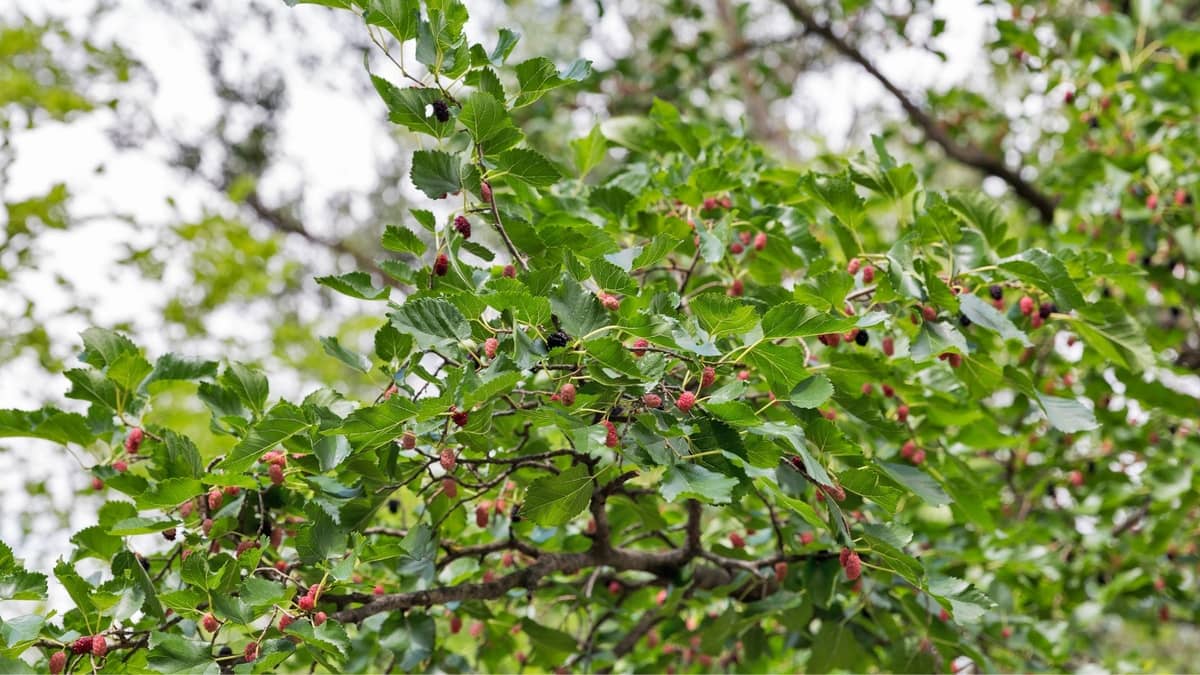Here is a step-by-step guide on how to grow a mulberry tree from a cutting and the right environment to grow it.
The mulberry tree is an evergreen shrub native to China, Japan, Korea, and eastern North America. It has been cultivated in China since approximately 3200 BC. Mulberries are used for food, animal fodder, and medicines. Mulberry leaves have been used to treat diarrhoea, dysentery, and gonorrhoea. The fruit is rich in vitamin C and has been used as a folk remedy for sore throats.
Contents
History
How to Grow a Mulberry Tree From a Cutting ? Mulberry cultivation has existed in China since the Neolithic era. The earliest Chinese mulberry was domesticated around 5000 BC and is found to be native to Henan, Hubei, and Anhui provinces. It is believed that mulberry was introduced to Japan from China in the early Jōmon period (10,000–300 BC). It is believed that it was introduced to Korea during the Yayoi period (300 BC-AD 500).
In China, mulberries were cultivated for more than 4000 years. Mulberry leaves and fruits are recorded in Chinese history. In ancient times, mulberries were cultivated mainly in the eastern and southern parts of China. By the Tang dynasty, mulberry plantations were spread throughout China.
How to Grow Mulberries From a Cutting ~ Step-by-step Guide

Step 1: Prepare the cutting.
Take a mature cutting of your mulberry tree. Make sure you select a healthy and vigorous cutting. Cut the cutting into four equal parts using a sharp knife.
Learn more about: The Right Fertilizer For Strawberries
Step 2: Prepare the soil.
Mix a handful of organic soil with one part peat moss, one part perlite, or vermiculite.
Step 3: Place the cutting in the soil.
Plant the cuttings evenly in the prepared soil. Add a rooting powder to help your cutting develop roots fast.
Step 4: Water your plants with the right amount of water.
Mulberries require a lot of water. When the soil becomes dry, add more water to keep your plants alive. Keep your mulberry well-watered. Mulberries are heavy feeders. It is best to give them water every day.
Step 5: Keep the mulberry tree growing healthy.
This means that you water it regularly and fertilize it at least once a month. Mulberries like to grow in a warm environment. They also need a lot of light.
Step 6: Enjoy your new mulberry tree.
Once mature, enjoy eating the berries or making some jam to use on your bread.
Care and Maintenance Of Mulberry Trees
How to Grow a Mulberry Tree From a Cutting? Caring for mulberry trees is easy, but they do require some attention. When you plant the mulberry tree, make sure you keep it in a warm location and protect it from the winter cold.
Ideal location
The mulberry tree requires full sun and good air circulation to grow and develop. They are hardy in USDA Zones 7 through 10.
Soil
Mulberry trees are not very picky about soil type, but they do need well-draining soil. If your mulberry tree has been planted in sandy soil, you should improve its drainage by adding organic matter such as compost or leaf mould to the soil.
Watering
Mulberry trees require water during the growing season and should receive about an inch of water every week during the growing season. The trees can be watered with either overhead irrigation or drip irrigation. Mature mulberry trees will tolerate periods of drought better than many other fruit trees, and they do not require a lot of water.
Fertilize
Mulberry trees are nutrient-rich plants, so they do not need fertilizer. They do however do well with yearly fertilization and grow best when there is adequate phosphorus (P) in the soil. Phosphorus is an essential element for healthy growth. You should not fertilize your mulberry tree unless you are planning on pruning it.
Prune
Mulberry trees are pruned annually to keep them at their optimum size. They are usually pruned at least every 3 years. The pruning should be done by trained professionals. This can be done at any time during the growing season to make them more desirable.
Uses Of Mulberry Trees
- Mulberries have been used in traditional medicine for centuries.
- Mulberry leaves, bark, and roots have been used as anthelmintic, antimicrobial, antifungal, antitumor, antiviral, anti-inflammatory, and antioxidant agents.
- The fruits are also used as a dye source, as well as a food and drink additive.
Final Words
This article teaches you how to grow a mulberry tree from a cutting. This guide can be used by both newbies and seasoned gardeners who would like to grow this popular tree. We hope this guide will attract more gardeners to grow this tree.
A garden is a place that relaxes us and reflects our personal style, it’s a place to spend time with loved ones and grow our own fruits and vegetables. Maybe you’re looking for design inspiration or plant selection, or you’re concerned about garden privacy, shady areas, or pests, but don’t worry, you’ve come to the right place.
